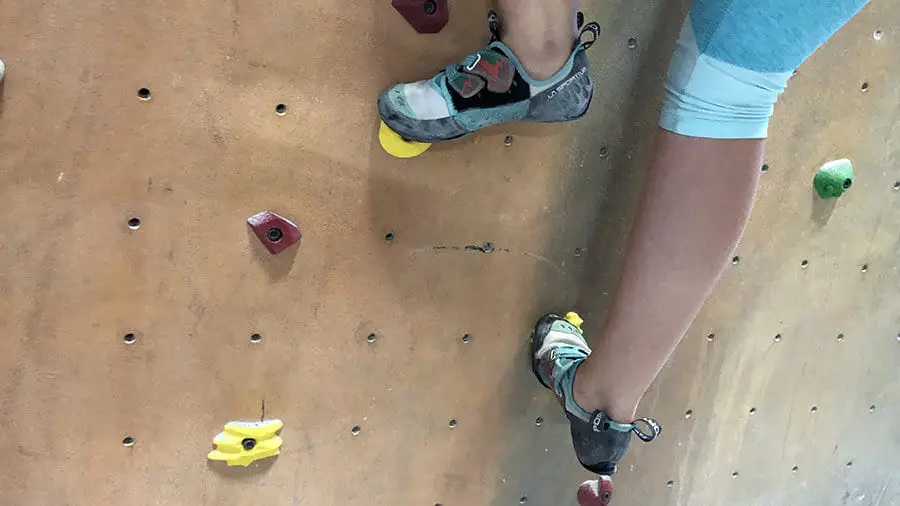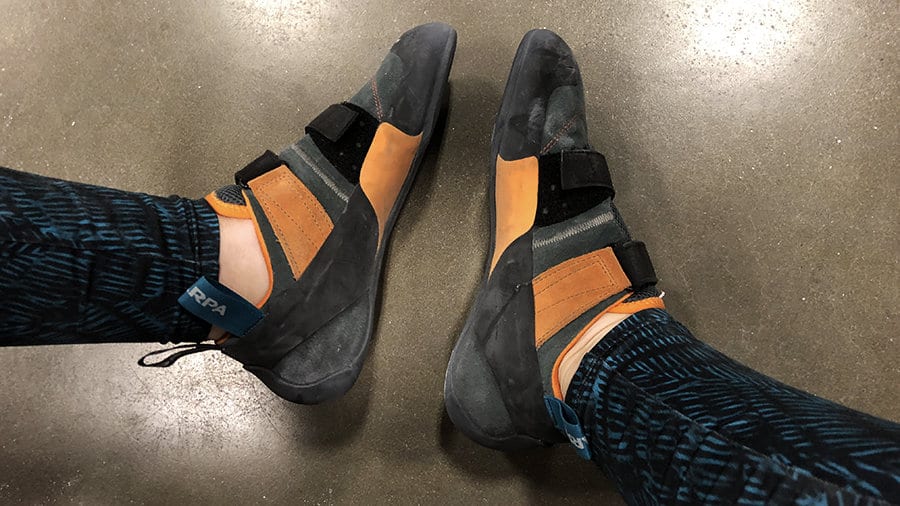I was taking my climbing shoes off today, giving my feet some rest between climbs, and wondering how tight should climbing shoes be so I did a little research.
How tight should climbing shoes be? Climbing shoes should be tight enough that there is no space for moving around in the shoe and your toes comfortably curved but your toe knuckles aren’t bunched painfully against the top of the shoe. Most climbers prefer shoes to be as small as they can fit their feet into, but if the shoes are too small, they may damage feet long-term.
Many climbers consider the fit of their shoes to be one of the biggest things that affects their climbing when it comes to gear so it is important to understand shoe fit as best you can.
What if your shoes are too tight
Climbers at all levels have been taught to fit into shoes that are multiple sizes too small to increase performance, but what happens if they are too tight? In addition to making climbing a painful experience, some of the most common side-effects of shoes being too tight are visual; bunions, corns and Hallux Valgus, which is when the big toe becomes angled in to compensate for the small space, are all common side effects. If you aren’t familiar with Hallux Valgus or bunions or cons etc, Google “climbers feet” and you find plenty of pictures with mangled feet.
In addition to the visual side effects, you also have nerve and blood vessel compression, which causes a tingling sensation from putting too much pressure on nerves and blood vessels, much like sitting on your feet for too long. Over time, if you continue to put too much pressure on nerves or blood vessels, you can have long-term damage.
Common injuries from falling (especially if you boulder and jump down instead of climbing down) are on your feet and ankles, which is worsened by shoes being too tight. When making your toes one unit, as all climbing shoes do, there is less support for impact in your feet and ankles if you fall.
An easy way to understand this is to take your shoes off and jump. When you land on your feet, watch your toes, they will separate slightly. The separation of your toes decreases the impact on the rest of your foot and ankle. If you were to do this test with climbing shoes, which I don’t recommend, you would feel additional pressure on the rest of your feet and ankles. The tighter your shoes are, the less impact your toes can support.
What if your shoes are too loose
If you have ever climbed in tennis shoes, then you may already understand how much a loose shoe changes the way you climb. Climbing shoes are constructed in a way to give your foot stiffness around the end of your toes so you can leverage your entire body weight on the tips of your toes without exhausting your feet.
Also, climbing are made to work with your skin (not a sock) so that you have the most grip between your feet and the wall. If there is too much space in the shoe, then you will not be able to fully engage the benefits of a climbing shoe.
If you’ve climbed in tennis shoes, you may notice that there is a lot of space between your toes and the wall so it is difficult to “place” your weight over the foothold. In addition, tennis shoes bend at the toe so you have to depend completely on the strength of your foot/toes to use small footholds.
To better understand the benefits that climbing shoes provide to climbers, here is a brief summary of the make of the climbing shoe:
Climbing shoes have three main parts: the outer layer, the middle layer and the inner layer.
The outer layer is what you can see and touch on the outside of the shoe. It is also the surface that grips the wall.
The middle layer is the layer that provides additional support to hold your foot in place with minimal effort on your part.
The inner layer is the layer that touches your skin (climbers usually don’t wear socks during climbs unless you are ice climbing or climbing in the cold).
The most support that a climbing shoe provides is a stiffness near the ball of your feet through the end of your toes.
If there is space between your toe and the end of your shoe, then your weight will not be supported by the stiffness and support in a climbing shoe. Thus, you would not be able to utilize the main benefit of climbing shoes.
In addition, if your shoes are too big, you have to re-engage that foot muscle over and over again instead of letting the shoe hold you in that position, causing you to get tired faster. When the shoe fit holds your feet with slightly curled toes, the middle layer will help keep your feet in that position that engages that foot muscle and thus, helps support your weight.
This is a common reason why climbers often have too small shoe size because they fear missing out on the high-performance assistance that well-fitted shoes provide.

The length of a climb changes how your shoes should fit
If you are climbing a half-hour or longer route, then you may want to have looser fitting shoes. Not “loose” shoes that have additional space between your toes, but “loose” as in you don’t have to think about your toes falling off while you are reaching for your next hold.
If your shoes are too tight, and you are climbing for long periods, your feet may become tired, but you won’t be able to take your shoes off and give them a break (because you’re on the side of a cliff…) so they need to fit and be comfortable enough that you can keep climbing.
In contrast, short bouldering climbs, especially at a gym, allow you to take frequent breaks and take your shoes off while you spot other climbers. This makes it easier to have tighter shoes without worrying about being stuck on the wall wishing you could take a break and remove your shoes.
Keep in mind, however, that as you climb, your feet swell so even if it is a short climb, you should still be cautious of how tight your shoes are.
I have seen friends climbing with shoes that are so tight that they
1) don’t want to take off their shoes because they don’t think they can put them back on, or
2) they take off their shoes and have to stop climbing because their feet have swelled so much that they can’t put their feet back in their shoes. So keep that in mind as well.
Choosing and caring for your shoes
There are plenty of great tips from gurus and outfitters about choosing and caring for the right fitting shoes. Here are a few that I thought were super useful.
- Shop/try on your shoes during the afternoon: According to REI, the best time to shop for climbing shoes is in the afternoon because your feet can swell up a full size throughout the day. If the afternoon isn’t possible, go for a short run or strenuous walk before trying on shoes so that the blood is flowing in your feet.
- Just like in running shoes, different brands fit different. Try the shoes on in-person before purchasing so you can be sure you have the right fit. I usually try it on in person and then find the same brand/shoe/size online so I can get the same price. If this is something you want to do, I would ask your local climbing outfitter if they do a price match so you can help fund your local economy. Here is my climbing shoe recommendation.
- Try to keep your shoes at room temperature. Throughout last summer, I had my shoes in the trunk of my car so I could go climbing at a moment’s notice. The problem is that we had record high temperatures and my car was frequently over 100 degrees Fahrenheit. I started to notice my shoes shrinking and it turns out that is common. Don’t make the same mistake I did!
- Stay hydrated while climbing. This may not sound like a tip for choosing and caring for your shoes, but if you are dehydrated, your feet may swell and thus – it affects how tight your shoes fit. If you want to have a consistent fit with your shoes, make sure you are consistently hydrated.
Conclusion
Climbing is supposed to be fun and if your climbing shoes are so tight that they distract from your climbing experience, then they are too tight. You shouldn’t be in pain while you are climbing, however, it shouldn’t be too roomy either. Wear a shoe that will allow you to focus on your climbing and also provide all the benefits of well-fitted climbing shoes.
More Buyer’s Guides:
- The Top 5 Crash Pads For Bouldering: How To Decide Which Is Best
- Diy Hangboard With Jugs And Edges For Less Than $15
- 6 Of The Best Belay Devices For Beginner Climbers
- The Best 11 Climbing Shoes Under $100
- Climbing Chalk: Chunky Vs. Fine
- The Best Chalk For Climbing And Bouldering
- Rock Climbing Starter Kits For Beginners Compared
- Liquid Chalk Vs. Dry Chalk For Bouldering (Hint: Dry Chalk Is Better)
- Top 5 Gear You Need In Your Climbing Pack For The Best Experience
- What To Wear While Bouldering
- Should You Upgrade To An Assisted-Braking Belay Device?
- Everything You Need To Know About Climbing Chalk
- 37 Things Serious Climbers Bring With Them To The Mountains
- Clothing For Climbing In The Gym – What Should You Wear?
- Can You Climb Without Chalk?
- How Tight Climbing Shoes Should Fit For The Best Performance
- Harnesses For Rappeling
- My Favorite Harness For Climbing
- What You Should Wear While Climbing
- What Affects How Climbing Shoes Fit?
- How To Clean Your Grigri
- How To Care For Your Climbing Rope

